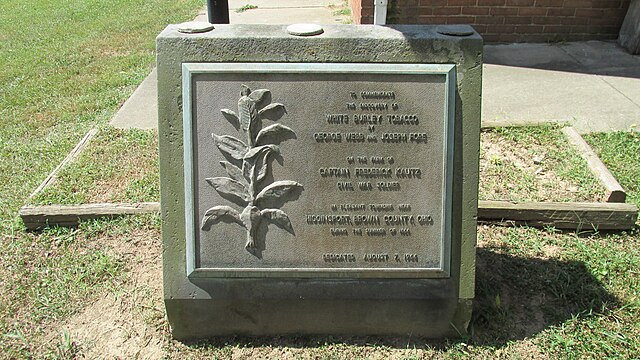Burley tobacco is a light air-cured tobacco used primarily for cigarette production. In the United States it is produced in an eight-state belt with approximately 70% produced in Kentucky. Tennessee produces approximately 20%, with smaller amounts produced in Indiana, North Carolina, Missouri, Ohio, Virginia, Maryland, Pennsylvania and West Virginia. Burley tobacco is produced in many other countries, with major production in Brazil, Malawi and Argentina.
White burley tobacco monument dedicated on 7 August 1964 and located at the Ohio Tobacco Museum in Ripley
Field of burley tobacco, drying and curing barn in the background, farm of Russell Spears, Lexington, Kentucky, 1940
Harvesting burley tobacco, 1940
Fields at the George Barkley Farm near Augusta, Kentucky, where Webb and Fore obtained the first white burley seed
Tobacco is the common name of several plants in the genus Nicotiana of the family Solanaceae, and the general term for any product prepared from the cured leaves of these plants. More than 70 species of tobacco are known, but the chief commercial crop is N. tabacum. The more potent variant N. rustica is also used in some countries.
Tobacco flakes, sliced from pressed plugs
Tobacco drying kiln in Myrtleford, Victoria, Australia, 2018. This kiln was built in 1957, and moved to Rotary Park in 2000. Kilns of this design were built from the early 1930s through to the late 1960s.
Basma tobacco leaves drying in the sun at Pomak village in Xanthi, Greece
In Minas Gerais, Brazil.








